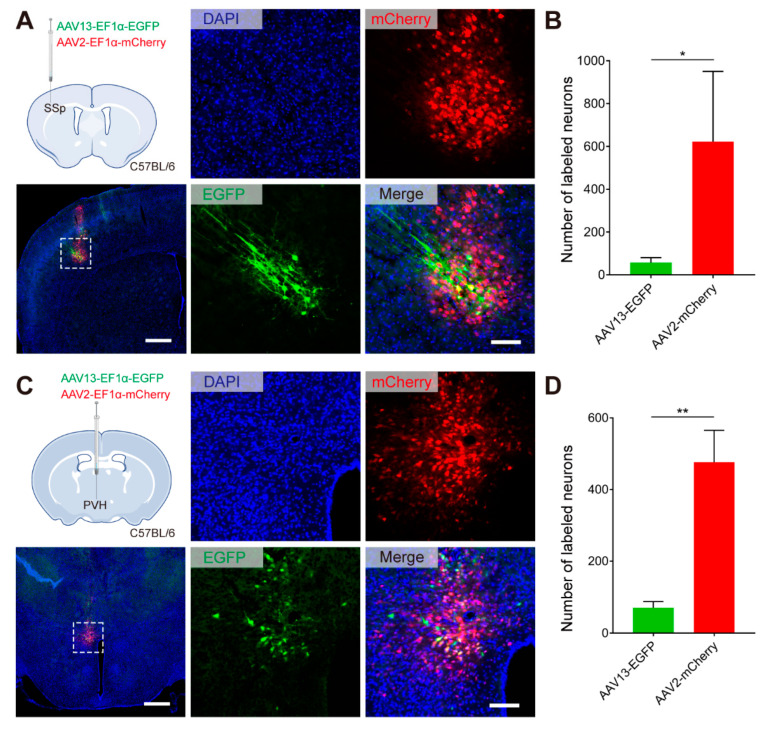An Effective New Adeno-Associated Virus (AAV) Serotype – AAV13

Recently, a study has demonstrated that Adeno-Associated Virus 13 (AAV13) has the characteristics of precise local gene delivery, limited diffusion range and stringent anterograde labeling. It is also well suited for targeting small nuclei, sparse labeling, and functional monitoring.

Not so long ago, we were excited about the potential of AAV as a local gene delivery tool due to its confined diffusion and the value in human gene therapy. The problem arises because of the non-target infection such as in situ diffusion, retrograde infection, or trans-synaptic transmission.
Fortunately, AAV13 appears in our field of research at this time. It was originally isolated and named AAV.VR942 by Schmidt et al. AAV13 has a similar structure to AAV2, although AAV3 is the closest related AAV serotype (Figure 1).
+AAV+Cladogram.+(B)+AAV13+and+AAV2+structural+comparison.jpg)
Figure 1. (A) AAV Cladogram. (B) AAV13 and AAV2 structural comparison
According to recent publication by Zengpeng Han et al, AAV13 is not only easy to produce, but it also has a smaller diffusion range and lower-intensity fluorescence expression than AAV2 when stereotactically injected into adult mice (Figure 2). Furthermore, AAV13 was proven to be capable of precise sparse labeling both with a single-viral vector strategy and dual-viral vector strategy. The precise sparse labeling allows scientists to study each neuron individually.

Figure 2. AAV13’s diffusion range is smaller than AAV2.
AAV13- EF1α-EGFP (BHV17100297) and AAV2- EF1α-mCherry (BHV17100124) can be found in Biohippo.
In addition, Zengpeng Han et al found that AAV13 permits functional monitoring in a mice reward experiment by labeling the ventral tegmental area (VTA) with AAV13 vector (AAV9-DIO-GCaMP6m) (Figure 3).

Figure 3. AAV13 can be used for functional monitoring.
In summary, AAV13 is a promising AAV serotype for gene delivery and gene therapy, particularly in the central nervous system.
Message from Biohippo: The AAV13 has significant potential as a new research tool. It may allow you to broaden the scope of your research and deepen its focus. Biohippo can assist you in designing your own AAV13 to conduct your experiments. Please feel free to contact us at [email protected]. AAV13 vectors used in this paper are also available in Biohippo.
| Name | SKU | Type |
| rAAV-CMV-EGFP | BHV17100038 | Fluorescent protein |
| rAAV-EF1α-EGFP | BHV17100297 | Fluorescent protein |
| rAAV-CAG-DIO-EGFP | BHV17100425 | Fluorescent protein |
| rAAV-CAG-DIO-mCherry | BHV17100309 | Fluorescent protein |
| rAAV-EF1α-DIO-mCherry | BHV17100310 | Fluorescent protein |
| rAAV-EF1α-DIO-EGFP | BHV12400245 | Fluorescent protein |
| rAAV-CaMKIIα-Cre | BHV17100320 | Recombinase |
| rAAV-hSyn-SV40 NLS-Cre | BHV17100314 | Recombinase |
| rAAV-EF1α-DIO-Flp | BHV17100327 | Recombinase |
| rAAV-EF1α-DIO-N2cG | BHV12400625 | Helper |
| rAAV-EF1α-DIO-oRVG(19G) | BHV12400145 | Helper |
| rAAV-EF1α-DIO-mCherry-F2A-TVA | BHV12400134 | Helper |
| rAAV-EF1α-DIO-EGFP-T2A-TVA | BHV12400130 | Helper |
Moreover, we offer more than 1000 pre-made AAVs and a variety of customized services, including shRNA design and cloning, RNA interference efficiency screening, virus packaging (Lenti-Virus, Ad-Virus, AAV, etc.).
For more information, please visit our website: https://www.ebiohippo.com/en/services/by-services/virus-and-vectors-services.html.
NOTE: All images are cited from Han Z, Luo N, Wu Y, et al. AAV13 Enables Precise Targeting of Local Neural Populations. Int J Mol Sci. 2022 Oct 24;23(21):12806. doi: 10.3390/ijms232112806. PMID: 36361595; PMCID: PMC9653909. Link: https://www.mdpi.com/1422-0067/23/21/12806.
 Loading ....
Loading ....
